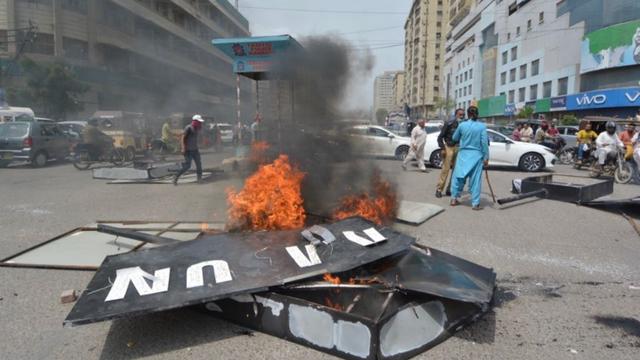An incident largely debated in the social media opens a window on the peculiar world of blasphemy charges in Pakistan. It took several days to netizens and the police to clarify what happened. Although not everything is clear, more details have now emerged.
On July 2, the rumor spread that a QR code posted on a Samsung promotional billboard outside the Star City Mall in Karachi was “blasphemous.”
According to eyewitnesses who posted on Twitter, it was unclear where exactly the blasphemy was, but a mob congregated, reminiscent that weeks before accusations had widely circulated that a QR code on 7-Up bottles looked like the name of Prophet Muhammad.
Samsung billboards were destroyed, and rioters entered into the Samsung store and tried to continue their destructive work. At some stage, they started asking each other in which sense exactly the QR code was blasphemous. They did not find an answer, but somebody explained that the QR code was related to a WiFi network to which the name had been given of Mu’awiya, the 7th-century first Umayyad caliph, followed by an insult common in all languages and referred to the allegedly less than honorable profession of his mother. Mu’awiya was the opponent of ‘Ali, and from this opposition the schism between Sufi and Shi’a Islam originated. The Shiites regard Mu’awiya as a villain, while for Sunni Muslims, although he made mistakes and ruled oppressively, he should still be respected as a companion of the Prophet and one of the scribes of the Holy Quran.
It is thus probable that the network was created for personal use by a Shi’ite citizen. To this day, no evidence has emerged that the Samsung QR code directed to that particular network, while by looking at the list of all the networks available in the area, the name of the one with the offensive allusion to Mu’awiya would have been found.
It is thus true that somebody offended Mu’awiya through the name of a Wi-Fi network, but it is unclear whether Samsung had anything to do with it (which Samsung later denied, while promising an internal investigation among its employees). Social media present different speculations, including the possibility of a provocation by Samsung’s competitors. Samsung has 23 percent of the Pakistani market for cell phones, and after the incident several pious Muslims posted videos of themselves smashing their Samsung devices.
Some media claimed that the riots were orchestrated by the anti-Shi’a organization Tehreek-e-Labbaik Pakistan, whose story has been told in details in a Bitter Winter series. Some even accused the extremist group of having fabricated the whole incident. Tehreek-e-Labbaik answered, ambiguously, that it had not incited anybody to resort to violence against Samsung.
With or without Tehreek-e-Labbaik, that mobs convene and start wreaking havoc in Pakistan when they hear charges of blasphemy without even understanding to what they refer is disturbing. Even more disturbing is that the police arrived and, rather than arresting the rioters, took 27 employees of Samsung into custody, threatening to file blasphemy charges, which in Pakistan can lead to the death penalty.
In 1895, French psychologist Gustave Le Bon published “The Crowd,” a very successful book where he maintained that those who become part of a mob are in a state similar to hypnosis and cannot resist the collective fury. The Karachi incident is a textbook example of Le Bon’s crowd psychology. Only, the police officers sent to control the mob became part of the mob themselves. – By Massimo Introvigne / Bitter Winter
Massimo Introvigne (born June 14, 1955 in Rome) is an Italian sociologist of religions. He is the founder and managing director of the Center for Studies on New Religions, an international network of scholars who study new religious movements.







